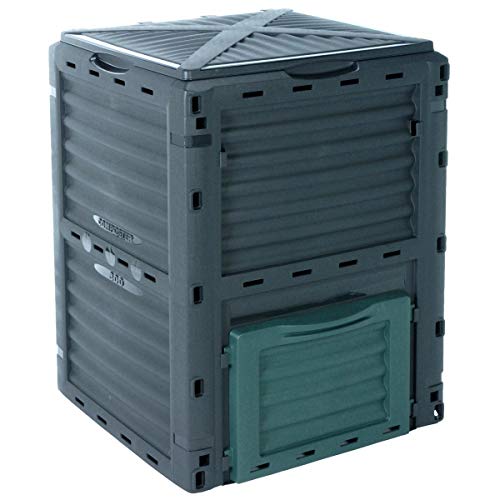Written by Terry Smith
Our site is reader supported so when you click a link to Amazon we may earn an affiliate commission.
UK’s best compost bins both large and small tested
This article was last updated on June 13th, 2022 at 9:42 pm
Whether you’re a first time gardener or an experienced ‘old hand’ compost is going to be a part of your life. If you’re tackling your garden for the first time, you will probably find that the newly dug up soil needs improving upon and compost is just the material for the job. Thankfully, compost is very easy to make for yourself and all you really need is a compost bin. The materials you are using to make your compost need to be massed/piled together properly in order for your compost to ‘cook’ properly and in a shorter time. The pile of materials should be layered with ‘brown’ then ‘green’ materials in an alternating pattern. You also need to ‘turn over’ your compost pile with a fork to produce heat, although some compost bin models have parts that you can spin to do this instead – these are often the best compost bins. Of course you can always make your own compost bin, but I find it better, and less time consuming to buy one that is specially made for the purpose with the features that I find useful.
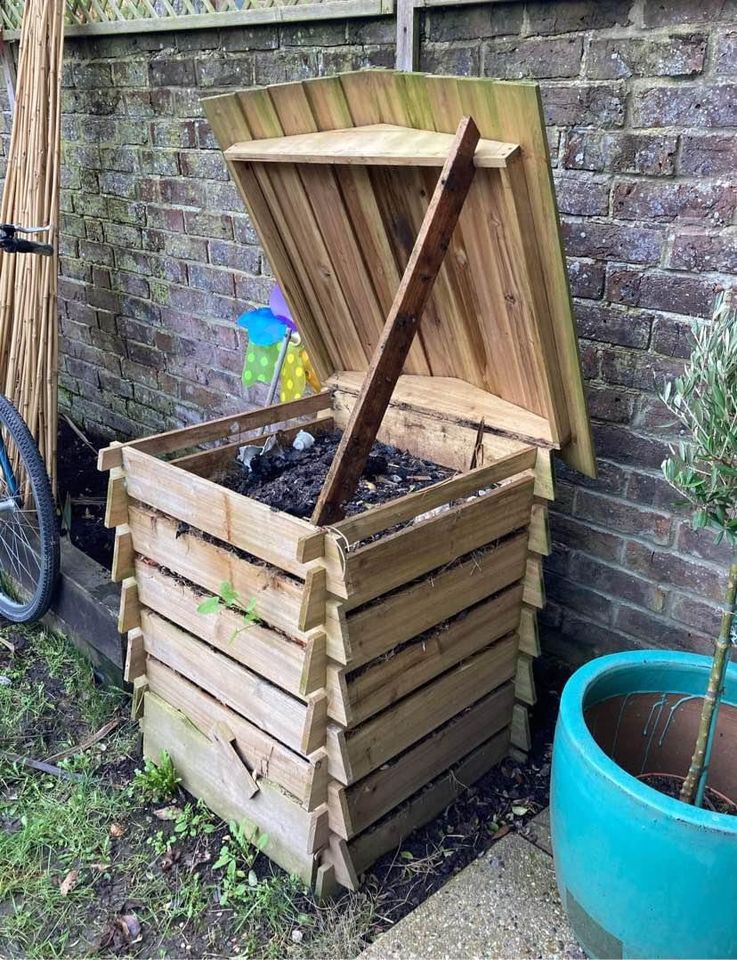
Best compost bins: my top picks from twenty years using and testing:
- Best overall compost bin- Easipet wooden compost bin – also happens to be the best wooden compost bin! [personally tested and proven]
- Best for small gardens- 4smile 300 litre compost bin
- Best compost tumbler- Squeeze dual compartment tumbler best of the best compost bin but at a price!
- Best compost bin for apartments- VermiHut Plus – best wormery style composter
- Best hot composter- Hotbin Extra
- Best large compost bin- DF Omer 420 litre bin – heavy duty and well built.
Buyers guide to compost bins
If you’re feeling a little lost when it comes to choosing your very first compost bin, or just about the composting process in general, don’t worry, we’ve got you covered.
In this detailed buyer’s guide, we’ll explain how to use a compost bin, how a compost bin works, discuss the different types of compost bin available to you and compare them, as well as providing any information we deem necessary or of interest to you.
Why should I use a compost bin?
Using a compost bin to transform your garden and kitchen waste into a nutrient rich material is one of the cheapest ways to improve the condition of your soil – it’s also a great solution to your green waste problem. I don’t know about you but my wheelie bin is always bursting collection day. In fact, other than the initial purchasing cost, which can be as little as ten quid or so, there isn’t much else to worry about. Personally, I wouldn’t go as low as a tenner for my compost bin, but you can get something like the bins in this photo for not a lot more than that:
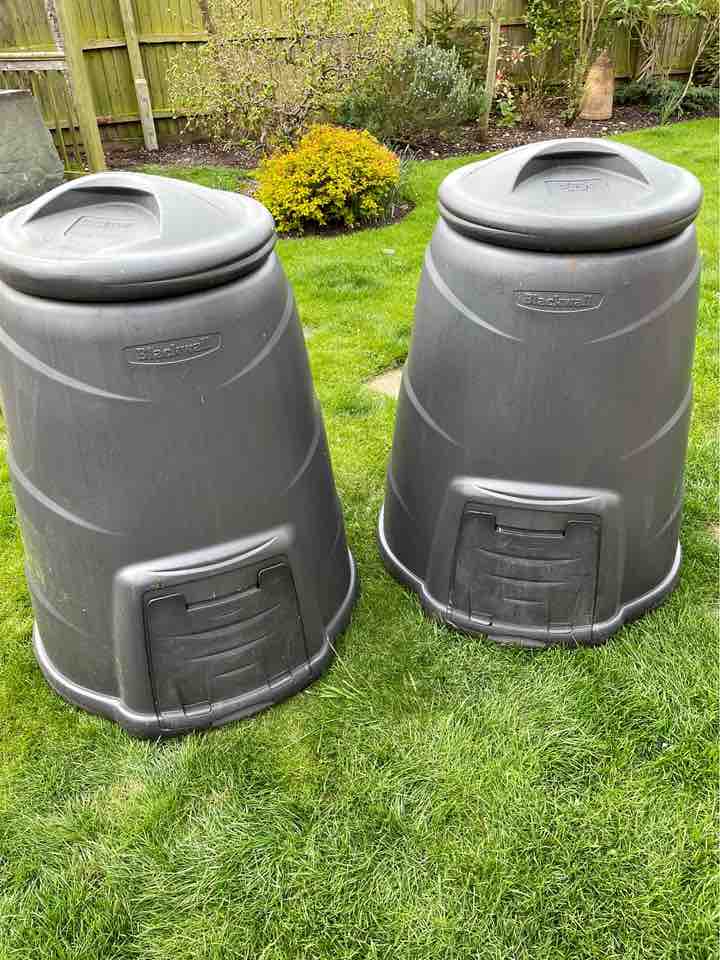
Even if you forked out for one of the high end compost bins, like the Hotbin, the money that you’d save on buying new soil and ready made compost from the garden centre, would more than make it worth it, over time.
How to use a compost bin
There aren’t any special skills needed to make your own compost, especially when you are just starting out. All you really need to know is what to put in your compost bin, and in what amounts.
A good ratio to start with, that has been proven to produce good results, is 40/60 green and brown material, put down in alternating layers. Having said that, I personally go with a ratio that is higher in carbon (brown material) as bacteria use more of it than nitrogen to create good compost. Having said that, I also tend not to be so scientific and just inspect my compost regularly to see if it needs more nitrogen or carbon adding. If there’s a strong smell, and it looks too wet, I add more brown material, if it looks too dry, I add more green stuff.
By green material, we are referring to any vegetable or fruit scraps, and things like grass clippings and dead leaves. Old cardboard, newspapers, and twigs and branches, can be used as brown material.
Unless you want to attract unwanted visitors like rats, you should avoid using meat or fish scraps in your compost bin, and just stick to nitrogen rich green materials, and carbon rich brown ones, like we mentioned above. Some people put perennial weeds in their compost bins, but as a beginner, I would recommend avoiding doing such as without using the correct technique, some of those weeds can survive the composting process.
Moisture is important for making good compost and it should always be damp, not wet, not dry, just damp. You also need to turn over the contents of your compost bin using a garden fork, spade, or shovel every few weeks. Alternatively, you can buy a tumbler compost bin like the Squeeze Dual compartment model that’ll make this part of the process easier.
Where you place your compost bin can also play a part in how well it does its job. Big variations in temperature are not ideal for composting so I always try to set my compost bins up in a sunny or lightly shaded spot where the temperature remains fairly steady.
Lastly, worms and other certain creatures play an important part in creating compost, so setting up your bin directly on the soil is always better than on concrete. There are even special compost bins called ‘wormeries’ that are specially built to encourage those wiggly wonders to work their magic. One of the best examples of this is the VermiHut Plus.
For all you newcomers to the world of composting, here’s an informative video on the basics for you to watch:
Different types of compost bin
As well as the wormery/vermicompost type that we just mentioned, there are a few other different versions of compost bins to choose from. Be it kitchen or apartments, to large gardens, there is a compost bin we can all take advantage of. Let’s take a quick look at what’s available, shall we?
Plastic compost bins
Plastic compost bins are usually inexpensive to buy and quite compact, making them a good choice if you are short on space, like the 4smile budget bin. Although some plastic bins have some ventilation, many do not, and this has its pros and cons. On the one hand, it allows the bin to retain heat better and the lack of light prevents the growth of weeds, but on the other, some cheaper plastic compost bins don’t allow for well needed air circulation and flow.
Wooden compost bin
These can be bought flat pack style and assembled, or you can make one yourself fairly easily from old crates, fence panels, etc. the advantage that wooden compost bins have over most plastic ones is that they allow air to get into your compost pile, and this helps speed up the process. Some wooden compost bins don’t come with any kind of lid or cover, so you’ll need to check and , if necessary, sort that out for yourself to stop rain getting in there. Alternatively, you could follow our advice and buy a beehive style wooden compost bin:
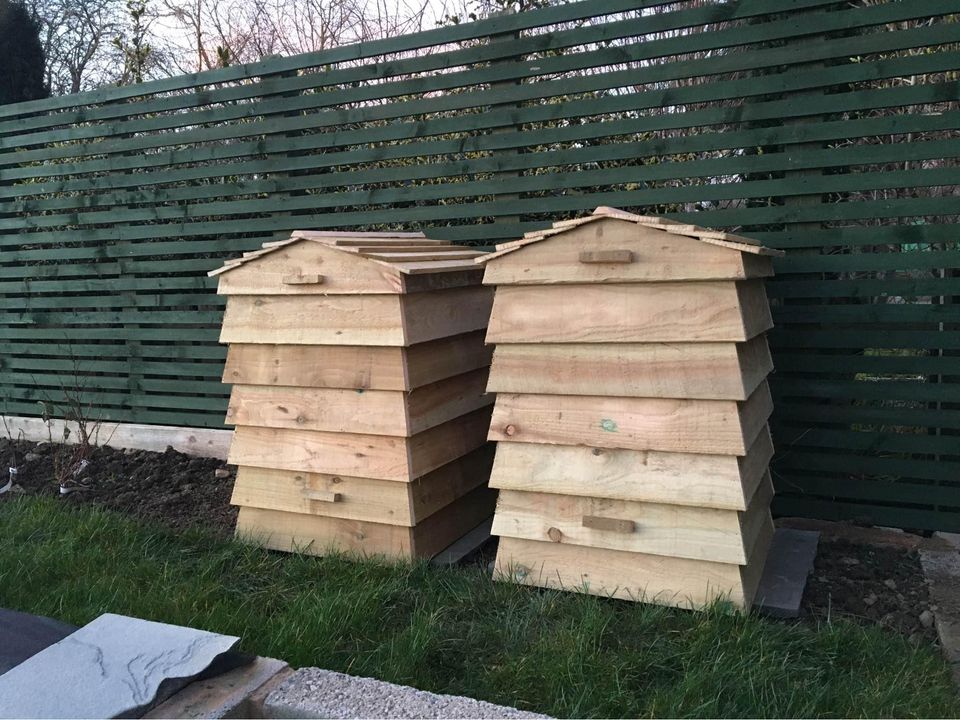
Hot compost bin
Making your own compost isn’t the fastest process in the world, but if you’re in a hurry, you can speed things up by using a hot compost bin. Thanks to insulated inner layers, these bins operate at higher temperatures than a plastic or wooden compost bin, and this results in your compost being ready to use in a fraction of the time. The downsides to hot composters are that they are more expensive, need to be turned over more often, and it takes time to get used to using them and produce the required results. Even with the excellent Hotbin, it took us a while to get things just as we wanted.
Wormery
Made up of multiple layers of trays, wormeries are another great choice for people who don’t have a ton of space in their garden. They are very easy to use, requiring only that you fill the trays with the right material and add the worms. What is important to know about this kind of compost bin, is that it doesn’t produce traditional compost, but instead gives you a nutrient rich liquid fertiliser that you can distribute with a watering can or sprayer, as you wish. What’s more, most of these vermicomposters even come with a built in tap for quick access to the ‘compost tea’s you can see here
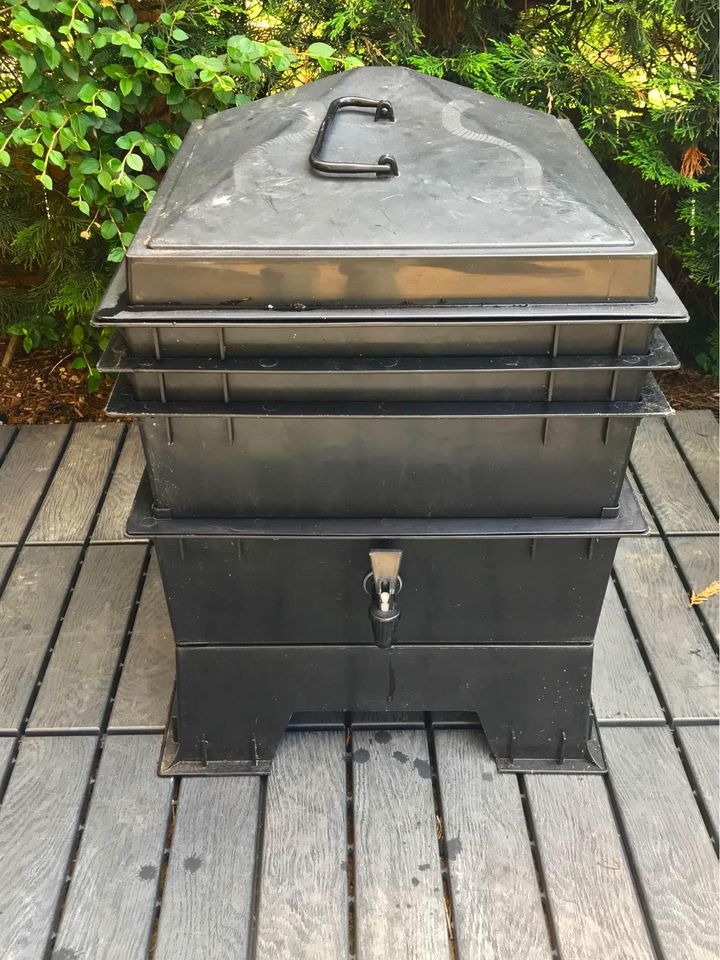
Tumbler
One of the most difficult parts of the composting process, when using a compost bin, is turning over the material every few weeks. Due to most compost bin designs, it can be hard to get in there with a garden fork and get the job done. Tumblers make this much easier as you can spin them around, but there is a limit to how much you can load in a tumbler before it gets very heavy and difficult to move.
Other things to think about before buying a compost bin-
Size and shape
The size and shape of your garden will play a part in which type of compost bin will suit you best. Square shaped bins fit into corners of the garden neatly and will blend in nicely, especially wooden ones, whereas round, plastic, compost bins will stand out more. On the plus side, round bins are less likely to have cold spots that are hard to reach with a fork, spade, or shovel.
Another thing to think about is how much time you have to dedicate to your compost, as a large compost bin, such as the 420 litre DF Omer model, will need more attention to keep it working properly, and the manual labour required will increase too.
Air flow/ventilation
Good ventilation is important for the material inside your bin to break down into compost. If there is insufficient air flow, there’s a good chance that you’ll end up with some stinky sludge rather than beautifully moist and fertile compost. However, if the holes, gaps, etc. in the bin are too large, you might find it more difficult to keep the temperature inside the bin high enough, so balance is key. Just compare the plastic bin in the following image with the two from the earlier photo. Can you see how this one has been designed to allow proper ventilation?
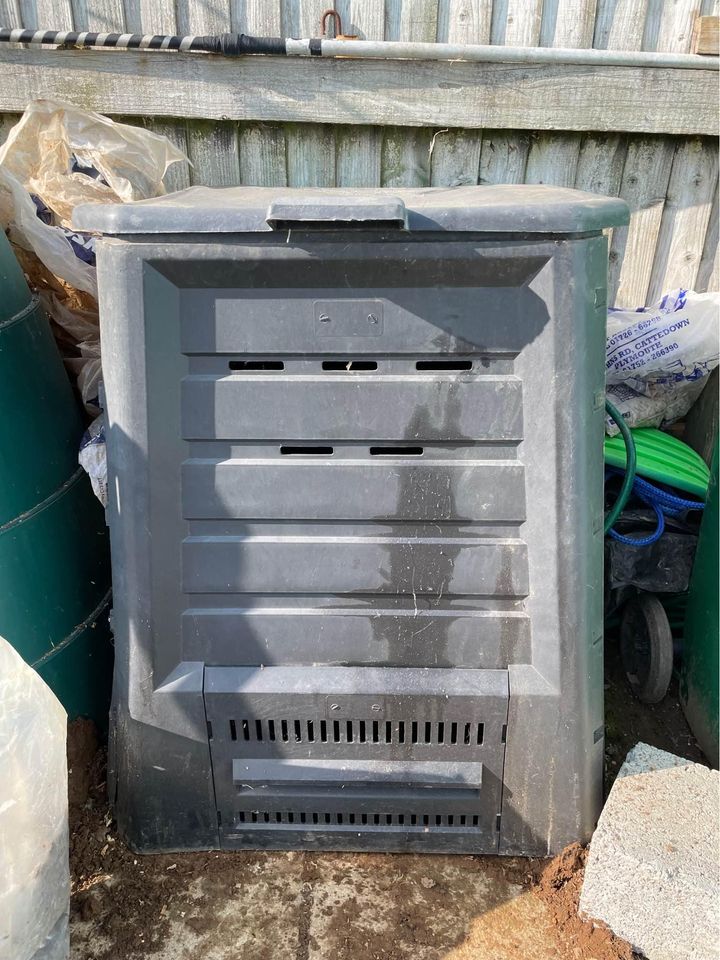
Cost
How much are you willing to spend on your compost bin? The prices of these products vary quite a lot, from cheaper, plastic bins, to more expensive insulated bins or tumblers. Just look at the difference in price between the 4smile bin and the Hotbin; quite a price gap. You can also save money by making your own, and it’s not a complicated task to do so, but most people prefer the convenience of buying one ready made.
Material
The main two materials are plastic and wood, but you can also find metal bins and tumblers out there too. Obviously, wooden products like the Easipet compost bin, are better for the environment than plastic, but they don’t retain heat quite as well, and you have to make sure you paint or stain them to avoid damage from rot and insects.
If you are going to opt for a plastic compost bin, please buy one made from recycled plastic for the sake of the planet. Also, you should try to find one that has some kind of ventilation and some way to easily access the lower part of the bin, as it can be hard to get a pitchfork in the smaller ones.
These days, you can also buy compost caddies, which are small, sealable bins that you keep in the kitchen and add vegetable and fruit waste to them until there’s enough to add to your main compost bin. Many of these are made from metal, like this one:
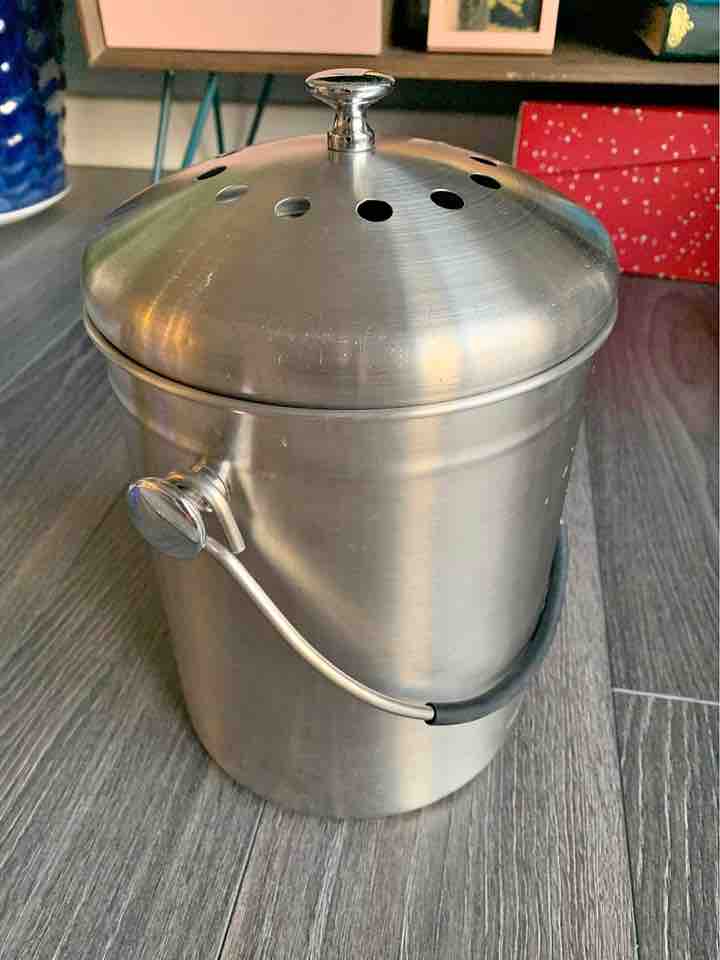
Best compost bin reviews and tests
Being the good old sorts that we are here at garden toolbox, we took it upon ourselves to test out a large selection of the most popular and best rated compost bins available in the UK, so that you can have a better idea about which ones are really worth the money. Below you’ll find reviews of the products we chose as the cream of the crop.
1. Easipet Wooden Compost Bin 328L in BeeHive Style
When trying to choose a compost bin as our best overall, we decided that it should be a good all-rounder, and something that would suit the majority of people here in the UK. So, with that in mind, we opted for this wonderful wooden compost bin from Easipet.
First off, it’s nice and compact and this we decided was an important factor as there are more small to medium sized gardens than large ones. At 74cm wide and deep, and 80cm high, you can tuck this into the corner of your garden and it won’t be getting in the way of you using your lawn mower or strimmer, for example.
Despite these compact dimensions, this Easipet compost bin can actually hold a decent amount of material- 328 litres, and because it’s made of good quality wood, you don’t have to worry about the bin getting misshapen or warped out of shape if you fill it right up. This is something that puts me off filling plastic bins to the max.
Wooden compost bins aren’t usually as good as plastic ones when it comes to trapping heat inside, but thanks to the beehive style design of this one, complete with a large hinged roof, it more than holds its own. What’s more, that roof makes it easy to access the contents for mixing and there’s also a removable section low down on the bin where you can pop a garden fork in.
One of the best features of this beehive design is that the wooden slats have spaces between them, and this gives the kind of excellent ventilation that is so hard to find on plastic compost bins. The bottom is also open so as to allow worms to crawl up and aid the decomposing process, but this means it’s probably not the best choice for leaving on a shard surface like concrete..
The easipet beehive compost bin arrives as a flatpack but assembly won’t cause you any nightmares. Everything just slots together really easily and there’s no need for any special tools or DIY skills, so a complete beginner would be fine with it.
What more can I say? This ticks all the boxes for me, and as long as you’re willing to give it a coat of stain, paint, or some other preserver, every now and again, it should last you a fair while.
Pros
- Compact dimensions means you don’t need a ton of space
- Wooden compost bin with a natural look and feel will fit into any garden
- Beehive design looks great and has practical features like a large hinged roof
- Removable lower section for easy access
Cons
- You’ll need to occasionally coat the wood to prevent weather and insect based damage
2. 4smile 300 Litre Garden Composter Bin
If you’re strapped for space in your garden, you might be thinking that having a compost bin is out of the question, but that’s not so. With dimensions of 61cm wide, 61cm deep, and 83cm high, the 4smile compost bin is ideal for smaller gardens.
With a capacity of 300 litres it falls just short of our best overall compost bin, but it’s not something that you would notice, and this bin will produce enough compost for any small to average sized property. I have one of these and have tested it extensively – it sits in the garden quite nicely, not obtrusive at all and just does it’s job:
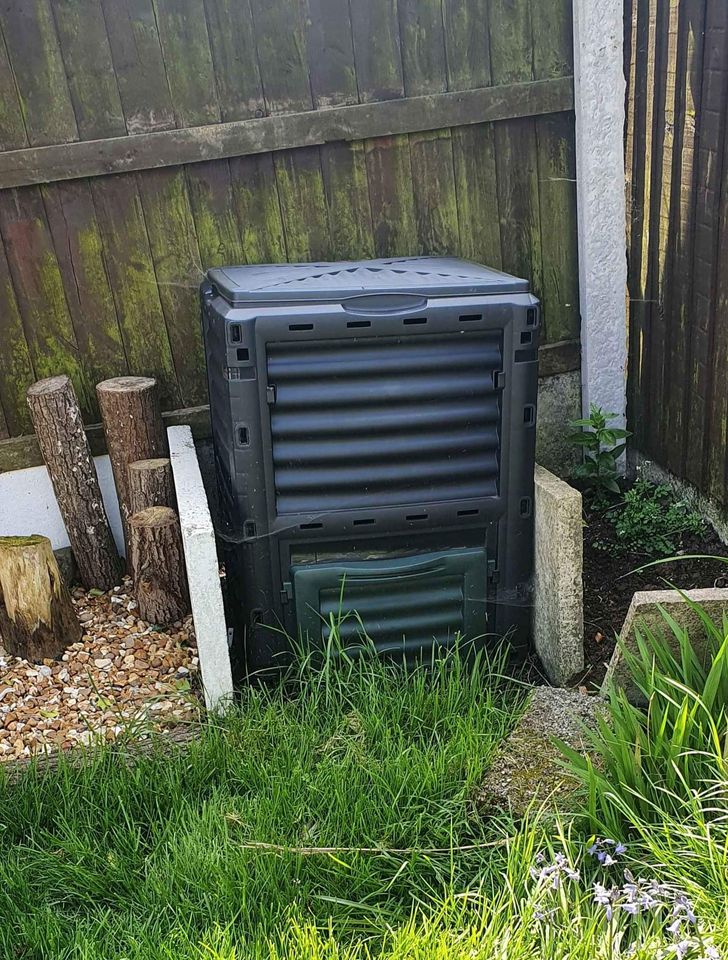
The 4smile compost bin is made from recycled plastic and all the pieces slot together without the need for tools. As much as I enjoyed the easy assembly, I had my doubts about how sturdy the finished structure would be, but I’m pleased to be able to say my worries weren’t warranted. Having said that, I don’t think it would stand up to strong gales, so you’d probably be best securing the bin to a fence or something.
Accessing the contents of the bin is so easy with this compost bin thanks to a large hinged roof and a lower hatch door that is a piece of cake to remove and reattach. The lid has a clip to keep it in place, and it worked just fine all the time we were testing it, but it is plastic so it might wear down over time. Still, that’s nothing a rock or brick on top won’t fix.
Thanks to multiple air vents, you actually get decent circulation inside this plastic compost bin, and that’s not something you’ll hear me saying too often. It’s not quite as good as the wooden Easipet compost bin, but again, it isn’t that far behind. The downside to these vents is that you will get some rain getting inside, especially when it’s a heavy downpour.
One area where the 4smile bin stands taller than its rival is price. This compost bin can certainly call itself a budget product, but don’t let that fool you into thinking it is low quality. Somehow, the makers have kept costs low and delivered a cracking little compost bin that doesn’t take up much space.
Pros
- Low cost compost bin, perfect for smaller budgets
- Good choice for smaller gardens
- Multiple vents provide good ventilation for a plastic compost bin
- Traps heat well
Cons
- Would need tying down in case of strong winds
3. Squeeze Large Compost Tumbler Bin -Outdoor Garden Rotating-Dual Compartment
One of the most complained about aspects of using a compost bin is having to get in there with a fork and turn the contents over every few weeks. Depending on the design, this task can range from ‘a bit fiddly’ to ‘are you having a laugh?’
Compost tumblers are a way around this but you do have to pay a premium for the privilege of being able to simply spin the barrel around. This model from Squeeze, however, won’t break the bank and is our choice for the best tumbler.
This twin compartment tumbler can hold a total of 43 gallons (2x 21.5), that’s around 162 litres (I think), so this composter can’t really compete with the likes of the DF Omer’s massive 420 litres, or even the 300 or so litres of the 4smile and Easipet compost bins. That’s not to say that this product isn’t useful, it’s just not the best pick for medium to large gardens.
On the plus side, the dual compartments mean that you can have 2 batches of compost on the go at different stages of decomposition, which can come in very handy for certain purposes. The bin holds heat well too, and there are multiple vents for airflow and also drainage points for excess water.
The main drawing point for this compost bin though, is that it’s so easy to mix up your compost. There’s no struggling to get your tools in there, or having to unclip hatches or sections of the bin, all you need to do is spin the barrel around 6-7 times and you’re good for a few days. Even when both sections are full, it isn’t hard to turn the bin due to the lower capacity.
The thickness of the plastic used in this product’s construction is very reassuring, the steel frame is built to last, and the whole thing feels really solid, much more so than even the 4smile compost bin, which is well built for the price.
The only thing that lets this product down, apart from the hatches being a bit on the small side, is that there are no clear instructions for assembly included, and I thought this was a silly thing to overlook. Thankfully, there’s a video on Youtube of someone assembling a near identical product, so if people get stuck, they can look their to guide them.
Pros
- Tumbling action means you don;t need to turn over the compost with hand tools
- Well built from solid plastic and a sturdy metal frame
- Dual compartments allow you to have 2 different batches of compost on the go
- Good ventilation and drainage for excess water
Cons
- Hatches should have been made larger to make filling the bin easier
This video does a good job of explaining the benefits of using a compost tumbler and also tips on getting the most out of them;
4. VermiHut Plus 5-Tray Worm Compost Bin
The VermiHut Plus is the new, upgraded, version of an already very popular vermicompost set up, building on a solid basic design with some very practical new features.
It comes with 5 worm trays as standard, but its modular design means you can buy extra trays if you require them, or even use less trays if you’re short on space such as on the balcony of a flat. You won’t get any worms in the box though, so you’ll have to go out and buy those yourself.
Although simple at first glance, this compost bin has some nice little features that aren’t commonly found on such products. For instance, there are little plastic feet for the bottom tray to sit in that are designed to trap ants, and the ‘M-board’ that’ll prevent the tray bedding from dropping into the liquid and also help with ventilation.
The thing you need to be aware of with this, or any vermicompost product, is that it won’t produce the amount of, or even the same kind of, compost that you can rub through your fingers like soil. What you get instead, is a fertiliser liquid, that you can drain out using the provided tap, and then spray it onto your plants.
Unlike most of the other compost bins we are featuring on this page, the VermiHut Plus can be used both indoors and outdoors. To make the indoor part a more pleasurable experience, the lid has been given air vents and coconut fibres are used to reduce odours. As the worms are added by you, there’s no need to have an open bottom sat on the soil either and this, again, makes it a good choice for flats/apartments.
The instructions that come with the VermiHut Plus aren’t the best, but working out how to set it up is really easy and shouldn’t cause anyone problems. The trays arrive packed inside one another though and they are jammed in tightly! It took a bit of time to pull them apart, and I don’t mind admitting that I was fairly red faced after doing so.
Apart from that, I have nothing to complain about. This setup is made from sturdy materials, you get everything you need apart from the worms and food scraps, and the price isn’t too bad at all for this kind of product. Definitely worth some consideration.
Pros
- Produces a nutrition-rich liquid fertiliser
- Built in tap makes extracting the fertiliser very easy
- Coconut fibres are used for reducing odours and helping to control moisture levels
- Modular design and can be made larger if you wish
Cons
- Can’t produce traditional compost, only liquid fertiliser
5. HOTBIN Compost Bin - Extra
Want your compost in a hurry? Or perhaps you need to use a lot of it? If that’s the case then you’re only realistic option is to shell out for a hot compost bin, and this one from Hotbin is the model we chose as the best of them.
The company who makes this product claims that it is 32 times faster than a standard bin. I don’t know how they worked that out, or even if it’s accurate, but I will say that it was by far the fastest that we tested and none of the others even came close.
However, I have to add that this super fast production of compost only happened during spells of warm to hot weather, and when the temperatures dropped, there wasn’t any real difference between this bin and any of the others. When the weather was right though…wow.
As well as giving you nutrient-filled compost at hyperspeed, the Hotbin also produces liquid fertiliser and there’s a handy little outlet, right there at the bottom, for you to retrieve it easily. I would have liked to have seen a tap like the one on the VermiHut plus, especially considering the price of this product, but the pipe works just fine.
Speaking of cost, this is one area that might put a lot of people off, but I guess it all comes down to how seriously you take your gardening and composting. If you’re new to all this, I’d probably go with a budget bin like 4smile product, or maybe even stretch to buy our best overall bin from Easipet, as hot compost bins are not the best things to learn on.
For those of you who have a bit more experience and are in the market for this kind of thing, you can do a lot worse than the Hotbox. It truly lives up to its name with thick insulated sides and a sealed lid, and isn’t like some of the cheaper ‘hot compost bins’ that don’t really work properly.
The 200 litres maximum laid might not sound like a lot, and is considerably less than many of the other bins in this list, but when you’re pumping out compost so regularly in summer, you won’t find yourself wanting for something larger.
Pros
- Extremely fast compost production under the right conditions
- Produces both compost and liquid fertiliser
- Very thick insulated walls and a sealed lid help to trap heat
- Comes with thermometer so you can keep n eye on the temperature
Cons
- In cold weather, there isn’t much of an advantage to using this kind of compost bin
If you’re interested in how to get your Hotbin up to the highest temperatures, take a quick look at this clip:
6. DF Omer Garden Composter Bin Made from Recycled Plastic – 110 Gallons (420Litre)
If you don’t want to spend a lot on a Hotbin, your other option for creating a lot of compost is simply to go big, and this DF Omer plastic compost bin is certainly that.
As standard, this bin can hold up to 110 gallons, or 420 litres, that’s 100 more litres than our best overall compost bin. But that’s not all, if you want to increase the size of the DF Omer, there is an extension section you can buy and this brings the max capacity to 172 gallons.
We didn’t get our hands on this extension to try it, but if it’s anything like the rest of the bin it’ll be very easy to attach, and will probably just click together. I only spent about 15 minutes putting this bin together, and that was without even looking at the instructions. This wasn’t a choice, it was because I couldn’t find any instructions to follow.
Quality-wise, the DF Omer is on par with the Squeeze compost tumbler and has very thick and robust feeling polypropylene plastic components, but still manages to feel lightweight when empty and easy to move around. Obviously, when you’ve got 400+ litres of compost in there, it won’t be going anywhere.
I really like the fact that the designers have thought about how the customer will fill this large bin up, and given it a split lid that opens up into a wide access point, perfect for shovelling stuff in without losing half of it on the ground. This is something that I felt the Squeeze tumbler could have done with.The lower access hatch isn’t quite as big as the lid, but still a practical size and you won’t struggle to remove the compost once it’s fully cooked.
All in all, this is a good quality, plastic, compost bin that has a larger than average capacity. The large opening in the top makes loading up a much easier task, and despite the lack of instructions, it is easy to set up in about a quarter of an hour.
Pros
- 119 gallons / 420 litre capacity as standard
- Can be modified to increase maximum load to 172 gallons
- Strong polypropylene plastic and very sturdy
- Large opening in the top makes for easy loading
Cons
- Lack of instructions, but thankfully easy to assemble anyway
Conclusion
Compost bins don’t just make wonderfully fertile soil, they keep your garden organised and clean. You’ve just got the lawn mower and grass trimmer out and cut the lawn. The hedge trimmer has sorted the bushes and you’ve done a bit of weeding too, and what about the leaves you collected with your leaf blower vacuum? All that green waste needs to go somewhere and a compost bin is the solution absolute. A compost bin needs to be sturdy and well designed to ‘cook’ the waste(heat it up to speed up deterioration), soil needs to be easily removed from a compost bin, and it needs to be built to last. To save you the time and effort it takes to search through the numerous brands and models available in the UK, we have chosen the best compost bins and reviewed based on the key criteria mentioned.



